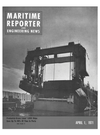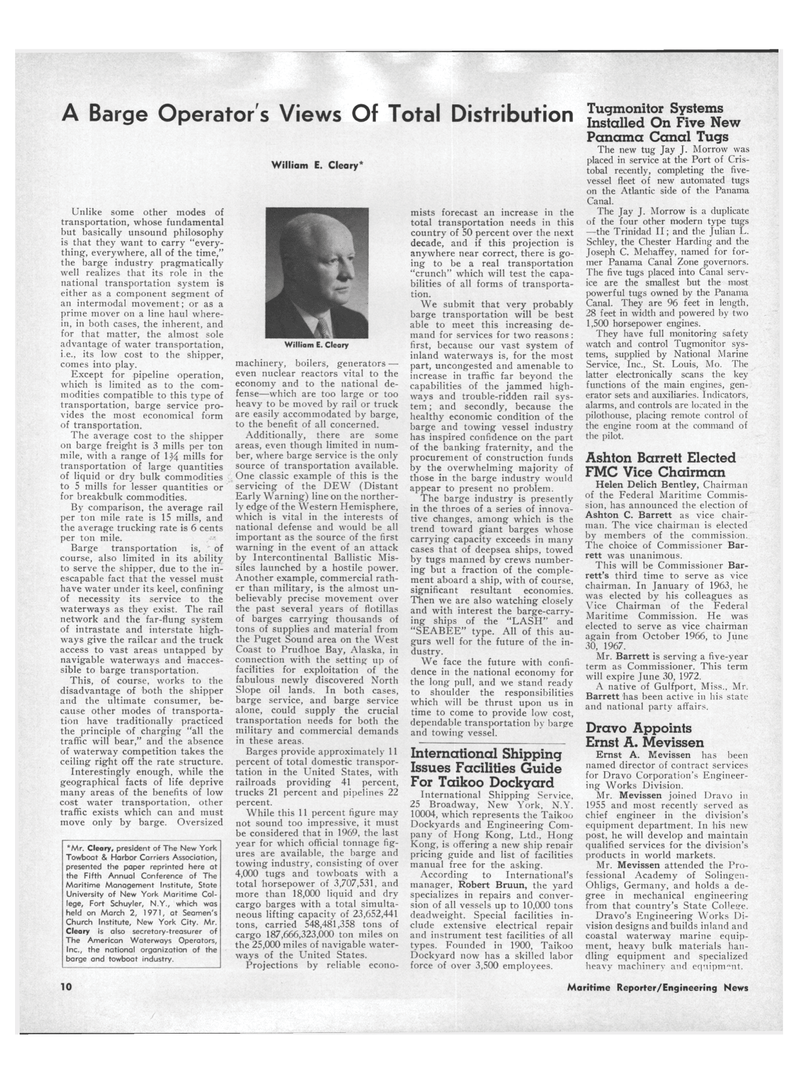
Page 8: of Maritime Reporter Magazine (April 1971)
Read this page in Pdf, Flash or Html5 edition of April 1971 Maritime Reporter Magazine
A Barge Operator's Views Of Total Distribution
William E. Cleary*
Unlike some other modes of transportation, whose fundamental but basically unsound philosophy is that they want to carry "every- thing, everywhere, all of the time," the barge industry pragmatically well realizes that its role in the national transportation system is either as a component segment of an intermodal movement; or as a prime mover on a line haul where- in, in both cases, the inherent, and for that matter, the almost sole advantage of water transportation, i.e., its low cost to the shipper, comes into play.
Except for pipeline operation, which is limited as to the com- modities compatible to this type of transportation, barge service pro- vides the most economical form of transportation.
The average cost to the shipper on barge freight is 3 mills per ton mile, with a range of \Y\ mills for transportation of large quantities of liquid or dry bulk commodities to 5 mills for lesser quantities or for breakbulk commodities.
By comparison, the average rail per ton mile rate is 15 mills, and the average trucking rate is 6 cents per ton mile.
Barge transportation is, of course, also limited in its ability to serve the shipper, due to the in- escapable fact that the vessel must have water under its keel, confining of necessity its service to the waterways as they exist. The rail network and the far-flung system of intrastate and interstate high- ways give the railcar and the truck access to vast areas untapped by navigable waterways and inacces- sible to barge transportation.
This, of course, works to the disadvantage of both the shipper and the ultimate consumer, be- cause other modes of transporta- tion have traditionally practiced the principle of charging "all the traffic will bear," and the absence of waterway competition takes the ceiling right off the rate structure.
Interestingly enough, while the geographical facts of life deprive many areas of the benefits of low cost water transportation, other traffic exists which can and must move only by barge. Oversized *Mr. Cleary, president of The New York
Towboat & Harbor Carriers Association, presented the paper reprinted here at the Fifth Annual Conference of The
Maritime Management Institute, State
University of New York Maritime Col- lege, Fort Schuyler, N.Y., which was held on March 2, 1971, at Seamen's
Church Institute, New York City. Mr.
Cleary is also secretary-treasurer of
The American Waterways Operators,
Inc., the national organization of the barge and towboat industry.
William E. Cleary machinery, boilers, generators — even nuclear reactors vital to the economy and to the national de- fense—which are too large or too heavy to be moved by rail or truck are easily accommodated by barge, to the benefit of all concerned.
Additionally, there are some areas, even though limited in num- ber, where barge service is the only source of transportation available.
One classic example of this is the servicing of the DEW (Distant
Early Warning) line on the norther- ly edge of the Western Hemisphere, which is vital in the interests of national defense and would be all important as the source of the first warning in the event of an attack by Intercontinental Ballistic Mis- siles launched by a hostile power.
Another example, commercial rath- er than military, is the almost un- believably precise movement over the past several years of flotillas of barges carrying thousands of tons of supplies and material from the Puget Sound area on the West
Coast to Prudhoe Bay, Alaska, in connection with the setting up of facilities for exploitation of the fabulous newly discovered North
Slope oil lands. I n both cases, barge service, and barge service alone, could supply the crucial transportation needs for both the military and commercial demands in these areas.
Barges provide approximately 11 percent of total domestic transpor- tation in the United States, with railroads providing 41 percent, trucks 21 percent and pipelines 22 percent.
While this 11 percent figure may not sound too impressive, it must be considered that in 1969, the last year for which official tonnage fig- ures are available, the barge and towing industry, consisting of over 4,000 tugs and towboats with a total horsepower of 3,707,531, and more than 18,000 liquid and dry cargo barges with a total simulta- neous lifting capacity of 23,652,441 tons, carried 548,481,358 tons of cargo 187,666,323,000 ton miles on the 25,000 miles of navigable water- ways of the United States.
Projections by reliable econo- mists forecast an increase in the total transportation needs in this country of 50 percent over the next decade, and if this projection is anywhere near correct, there is go- ing to be a real transportation "crunch" which will test the capa- bilities of all forms of transporta- tion.
We submit that very probably barge transportation will be best able to meet this increasing de- mand for services for two reasons: first, because our vast system of inland waterways is, for the most part, uncongested and amenable to increase in traffic far beyond the capabilities of the jammed high- ways and trouble-ridden rail sys- tem ; and secondly, because the healthy economic condition of the barge and towing vessel industry has inspired confidence on the part of the banking fraternity, and the procurement of construction funds by the overwhelming majority of those in the barge industry would appear to present no problem.
The barge industry is presently in the throes of a series of innova- tive changes, among which is the trend toward giant barges whose carrying capacity exceeds in many cases that of deepsea ships, towed by tugs manned by crews number- ing but a fraction of the comple- ment aboard a ship, with of course, significant resultant economies.
Then we are also watching closely and with interest the barge-carry- ing ships of the "LASH" and "SEABEE" type. All of this au- gurs well for the future of the in- dustry.
We face the future with confi- dence in the national economy for the long pull, and we stand ready to shoulder the responsibilities which will be thrust upon us in time to come to provide low cost, dependable transportation by barge and towing vessel.
International Shipping
Issues Facilities Guide
For Taikoo Dockyard
International Shipping Service, 25 Broadway, New York, N.Y. 10004, which represents the Taikoo
Dockyards and Engineering Com- pany of Hong Kong, Ltd., Hong
Kong, is offering a new ship repair pricing guide and list of facilities manual free for the asking.
According to International's manager, Robert Bruun, the yard specializes in repairs and conver- sion of all vessels up to 10,000 tons deadweight. Special facilities in- clude extensive electrical repair and instrument test facilities of all types. Founded in 1900, Taikoo
Dockyard now has a skilled labor force of over 3,500 employees.
Tugmonitor Systems
Installed On Five New
Panama Canal Tugs
The new tug Jay J. Morrow was placed in service at the Port of Cris- tobal recently, completing the five- vessel fleet of new automated tugs on the Atlantic side of the Panama
Canal.
The Jay J. Morrow is a duplicate of the four other modern type tugs —the Trinidad II; and the Julian L.
Schley, the Chester Harding and the
Joseph C. Mehaffey, named for for- mer Panama Canal Zone governors.
The five tugs placed into Canal serv- ice are the smallest but the most powerful tugs owned by the Panama
Canal. They are 96 feet in length, 28 feet in width and powered by two 1,500 horsepower engines.
They have full monitoring safety watch and control Tugmonitor sys- tems, supplied by National Marine
Service, Inc., St. Louis, Mo. The latter electronically scans the key functions of the main engines, gen- erator sets and auxiliaries. Indicators, alarms, and controls are located in the pilothouse, placing remote control of the engine room at the command of the pilot.
Ashton Barrett Elected
FMC Vice Chairman
Helen Delich Bentley, Chairman of the Federal Maritime Commis- sion, has announced the election of
Ashton C. Barrett as vice chair- man. The vice chairman is elected by members of the commission.
The choice of Commissioner Bar- rett was unanimous.
This will be Commissioner Bar- rett's third time to serve as vice chairman. In January of 1963, he was elected by his colleagues as
Vice Chairman of the Federal
Maritime Commission. He was elected to serve as vice chairman again from October 1966, to June 30, 1967.
Mr. Barrett is serving a five-year term as Commissioner. This term will expire June 30, 1972.
A native of Gulfport, Miss., Mr.
Barrett has been active in his state and national party affairs.
Dravo Appoints
Ernst A. Mevissen
Ernst A. Mevissen has been named director of contract services for Dravo Corporation's Engineer- ing Works Division.
Mr. Mevissen joined Dravo in 1955 and most recently served as chief engineer in the division's equipment department. In his new post, he will develop and maintain qualified services for the division's products in world markets.
Mr. Mevissen attended the Pro- fessional Academy of Solingen-
Ohligs, Germany, and holds a de- gree in mechanical engineering from that country's State Collesre.
Dravo's Engineering Works Di- vision designs and builds inland and coastal waterway marine equip- ment, heavy bulk materials han- dling equipment and specialized heavy machinery and equipment. 10 Maritime Reporter/Engineering News

 7
7

 9
9
